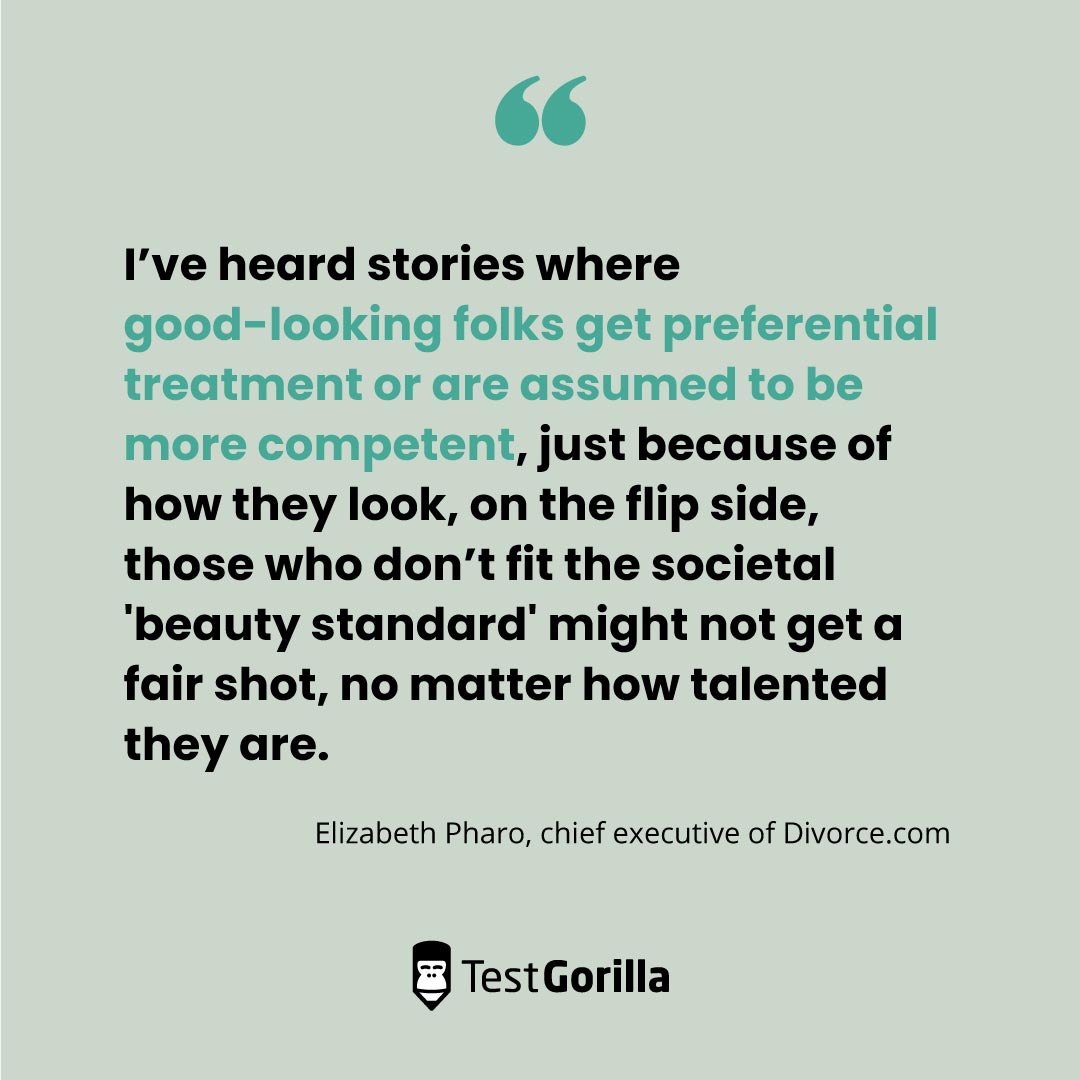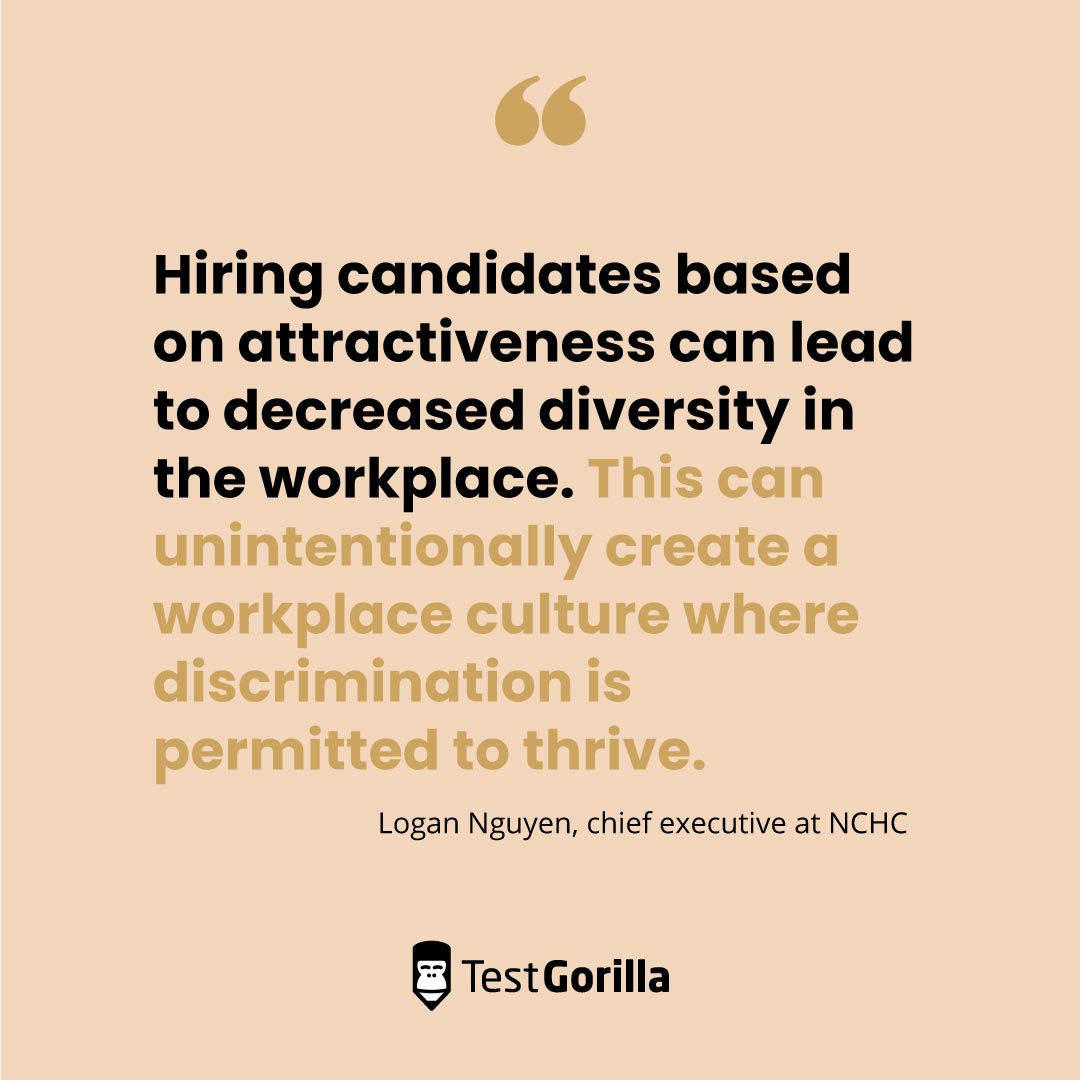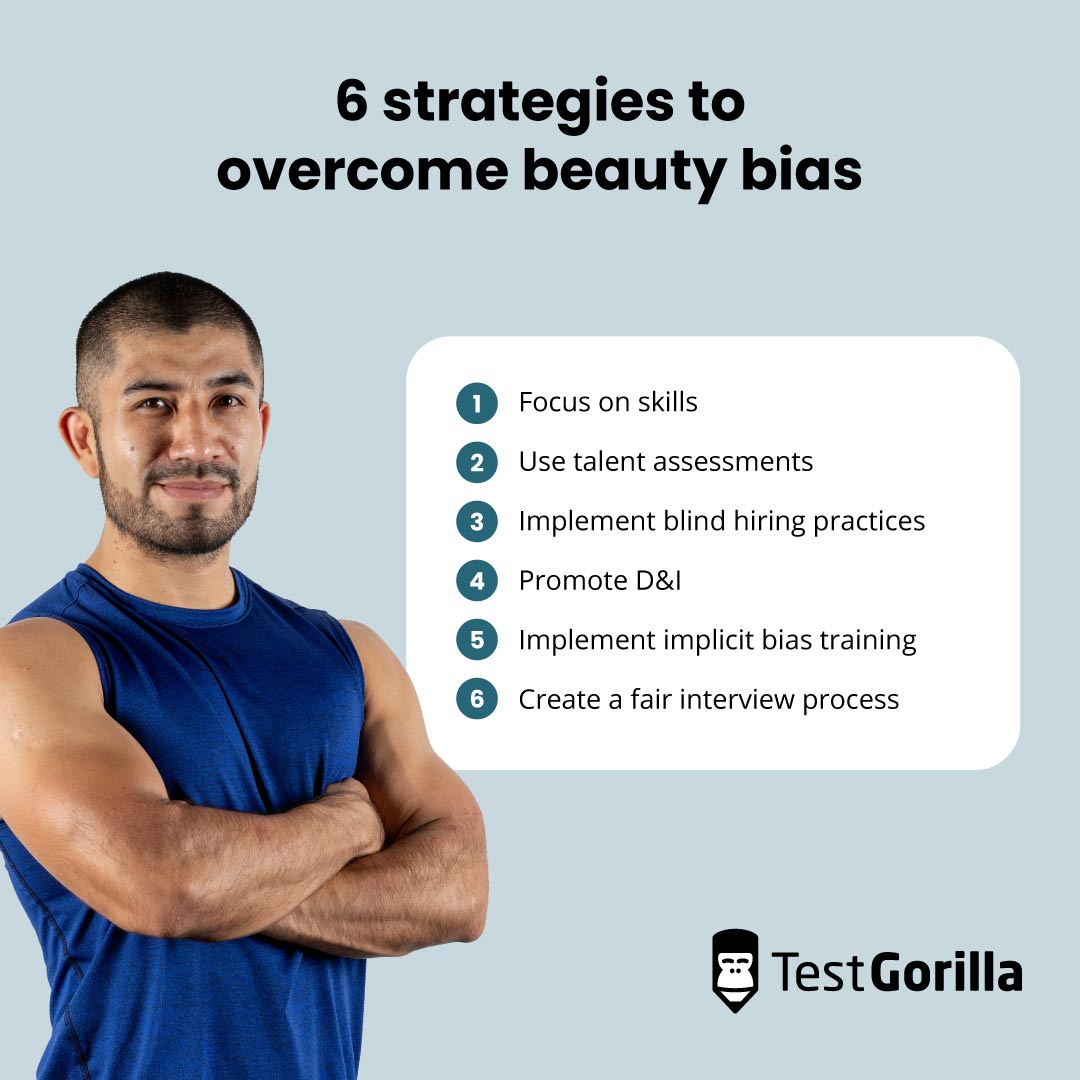In 2019, an Australian woman pleaded guilty to using fraudulent information on her resume to land a $185,000 job. This included using a photo of actress Kate Upton as her LinkedIn profile picture.[1]
Why? Because research shows that physically attractive job applicants are rewarded for their good looks.[2] This is something we call "beauty bias," or being influenced by "good looks" unconsciously because people associate them with positive traits.
When it comes to hiring, forward-thinking organizations strive to create fair and unbiased processes that evaluate candidates based on their qualifications, skills, and experience. For instance, to overcome discrimination based on gender, race, or sexual orientation, HR teams devise diversity and inclusion (D&I) policies and practices to mitigate unconscious bias.
In this article, we’ll examine the challenges faced by individuals who encounter biases due to their physical appearance.
We’ll also look at how skills-based hiring can help organizations to overcome unconscious biases, create a fairer recruitment process, and secure the best talent for their teams.
Looks matter: What is beauty bias?
Attractive people are often perceived as more competent, intelligent, and likable. Those who are less conventionally attractive, however, are perceived to be less healthy, trustworthy, and intelligent. The judgments we make about people based on their physical attractiveness is known as beauty bias.
"I’ve heard stories where good-looking folks get preferential treatment or are assumed to be more competent, just because of how they look," says Elizabeth Pharo, chief executive of Divorce.com.
"On the flip side, those who don’t fit the societal 'beauty standard' might not get a fair shot, no matter how talented they are. It’s a bit like judging a book by its cover, and we all know that's not how we find the best reads."
Case study: Hacking attractiveness biases in hiring? The role of beautifying photo filters
In this landmark study, researchers set up a hiring process where managers evaluated mock candidates for a variety of open roles to determine the impact of beautifying face filters on hireability.
Methodology:
Study 1: 223 managers evaluated White applicants presented with or without a beautifying filter for either a social worker or an IT specialist position.
Study 2: 212 managers evaluated Black and White applicants with or without beautifying filters for an HR specialist position.
Key findings:
In study 1, beautifying filters increased perceived hireability regardless of job type, especially when applicants were female.
In study 1, both male and female applicants with filtered photos were perceived as more competent, but only male applicants were perceived as having warmer personalities.
In study 2, beautifying filters increased the hireability slightly for White female applicants, but substantially for Black female applicants.
In study 2, the filters increased the perceived competence of Black (especially Black female) applicants but not of White ones. Filters also increased the perceived warmth of all groups except for White females.
What is the impact of beauty bias on hiring?
Candidates who don't fit societal ideals of beauty may find themselves at a disadvantage, regardless of their qualifications and capabilities.
This bias can lead to missed opportunities for talented individuals and companies alike, and create an unfair playing field. People who don't meet society's rigid understanding of beauty may also be the first to get fired or let go.
However, 'beauty' is subjective, and our understanding of it is heavily influenced by social and cultural factors. This can further marginalize ethnic minorities, women, LGBTQ+ communities, and people with disabilities.
Moreover, 'attractive' candidates are often perceived as more confident and capable, irrespective of their skills and experience. This means companies that don't address bias in hiring can experience more mis-hires and, as a result, higher employee turnover rates. All of this can severely impact their bottom line and company culture.
"Hiring candidates based on attractiveness can lead to decreased diversity in the workplace. This can unintentionally create a workplace culture where discrimination is permitted to thrive. It can also limit creativity and innovation in a company due to skill and experience deficiency in the workplace." - Logan Nguyen, chief executive at NCHC.
It's important for companies to address beauty bias in recruitment to build a diverse team of skilled professionals that perform better.
The best insights on HR and recruitment, delivered to your inbox.
Biweekly updates. No spam. Unsubscribe any time.
6 strategies to overcome beauty bias
"One of the major impacts of beauty bias is missing out on top talent," Logan says. "When a hiring process is influenced by beauty, talented and highly skilled candidates are often overlooked. This can lead to decreased innovation and less satisfied employees."
Here are six strategies you can use to overcome beauty bias in hiring so you can attract and retain the best talent.
1. Focus on skills
It's important to emphasize the skills required for your open position and make sure job descriptions and requirements are clearly outlined.
When you state skills requirements in a straightforward way, it can be easier for people to honestly evaluate themselves – including their skills and strengths – before submitting an application. This can make it easier to narrow down your applicant pool and focus on candidates more likely to thrive in the role.
"Writing an inclusive job description is also important in encouraging candidates from all races, religions, and nations to apply. You don’t want to send a message out there that you’re looking for candidates with specific physical characteristics." - Logan Nguyen, chief executive at NCHC.
You also need to make sure interview questions are relevant to the role and focused on understanding the candidates' applied skills and experience. "Priority should be given to what's needed for the position," Logan emphasizes.
By shifting the focus to abilities and competencies in the application and interviewing process, you can minimize the influence of appearance-based biases.
2. Use talent assessments
Talent assessment software lets you objectively assess candidates based on the skills they have. Skills-based assessments help to reduce unconscious bias by quickly identifying candidates who have what it takes to succeed in the role, regardless of their appearance, educational background, or ethnicity.
This is why, according to our 2022 State of Skills-Based Hiring report, 91.1% of employers using a skills-based approach to hiring see an increase in diversity. Moreover, testing for skills also helps improve key business metrics like time-to-hire and cost-to-hire, while reducing mis-hires.
In fact, of the companies using skills-based assessments, 92.5% reduced their number of mis-hires, 91.4% reduced their total time-to-hire, and 89.8% reduced their overall cost-to-hire. This means significant cost savings for your business, so you can better focus on equitable hiring.
By using talent assessments to test for soft, hard, and transferable skills, you can also build a team of individuals who are not only a great fit for their respective roles, but also strong communicators, effective problem solvers, and adaptable learners. This gives you more wiggle room to secure the best talent, no matter what they look like.
Here are some talent assessments you can use to test for an array of skills:
3. Implement blind hiring practices
Consider removing identifying information such as names, photos, and personal details from resumes during the initial screening process. This practice helps to eliminate the chance for unconscious biases to influence the hiring process at the first step.
Other blind hiring practices you can use include:
Implement skills assessments or tests relevant to the role to evaluate candidates' abilities objectively. These assessments can be designed to closely simulate tasks the candidate would perform in the role.
Form interview panels that represent diverse perspectives to reduce the influence of individual biases. Then during the interview process, hide personal information about candidates from interviewers to prevent bias.
Provide interviewers with structured scorecards or rubrics to objectively evaluate candidates based on specific criteria.
Pro tip: TestGorilla has an anti-cheating measure that takes photos of candidates during their assessments, but employers can turn this feature off to make recruitment blind.
4. Promote D&I
A diverse workforce can transform your business. In fact, ethnically- and gender-diverse teams are more likely to financially outperform less diverse teams. Prioritizing D&I can also lead to more innovative problem solving, better team dynamics, and a company culture people are proud to be part of.
By actively promoting diversity, organizations can create an environment where all employees are treated fairly, irrespective of their appearance or background.
"Recruiters are more inclined to hire people who look or behave like themselves. Setting up an inclusive hiring team brings people with different backgrounds, experiences, and skills to the table, reducing the chances of biased decisions." - Logan Nguyen, chief executive at NCHC.
Here's how you can promote D&I in your company:
Ensure senior leadership is fully committed. Everyone needs to be on board when it comes to promoting D&I and communicating their commitment throughout the organization.
Conduct a thorough D&I assessment. This involves gathering and analyzing data and feedback about how your organization is performing with regard to meeting D&I goals. Then, you can develop a strategic plan that outlines specific goals, objectives, and initiatives for promoting D&I.
Aim for diverse representation, especially at all levels of leadership and management. Provide mentoring and development opportunities to diverse employees to help them advance in their careers.
Encourage employee resource groups (ERGs). ERGs represent different demographic groups within the company and provide a platform for networking, support, and advocacy for underrepresented employees.
Implement flexible work arrangements. This helps accommodate different needs and lifestyles while promoting work-life balance.
5. Implement implicit bias training
Encourage HR managers and interviewers to reflect on their own biases and preferences. By acknowledging and examining personal biases, individuals can make more conscious efforts to evaluate candidates based on their skills and qualifications, rather than relying on appearance-based judgments.
Then, implement implicit bias training that goes beyond addressing personal biases, and helps drive more conscious behavior company-wide. Here's how:
Identify training goals. Define clear objectives for the training, such as raising awareness about unconscious biases, understanding their impact, and providing strategies to mitigate biases.
Select a training partner or build internal content. Choose whether to partner with an external training provider that specializes in unconscious bias or develop internal training content.
Involve relevant stakeholders. Invite HR, diversity and inclusion teams, and other relevant stakeholders in the planning and execution process.
Schedule training sessions. Plan the training sessions, considering factors like timing, duration, and participant availability. Make sure to offer multiple sessions to accommodate different shifts, teams, or departments.
Make sessions interactive. Choose an interactive format that engages participants through discussions, case studies, role playing, and activities. Use real-world examples and scenarios that resonate with the participants' experiences.
Encourage participants to apply what they've learned. Then see how it impacts daily interactions and decision making. Make sure to provide resources for continued learning and reinforcement, such as articles, videos, and workshops.
6. Create a fair interview process
It's crucial to implement structured interviews that include standardized questions for all candidates. This approach ensures consistency and allows for a fairer and more accurate evaluation of candidates based on their responses rather than subjective impressions.
As mentioned, you can also form interview panels that represent a range of perspectives and backgrounds. Including individuals with different experiences and viewpoints helps mitigate the influence of personal biases and promotes a more inclusive evaluation process.
"One of the best ways to create a fair hiring process is to ensure interviews are standardized. Have a set of questions you want the panel to ask. They should not deviate or go off-script. Most importantly, all candidates should be given the same amount of time to respond." - Logan Nguyen, chief executive at NCHC.
Other ways to create a fair interview process include:
Getting detailed applicant feedback. Encourage interviewers to provide detailed feedback on each candidate's performance. Then make hiring decisions through consensus, considering input from all interviewers.
Providing feedback to interviewers. Offer interviewers feedback on their candidate evaluation techniques and areas for improvement. This helps encourage a culture of continuous learning and growth among interviewers.
Using the right tools. Skills assessments, technical tests, or work simulations objectively evaluate candidates' abilities and provide concrete evidence of candidates' qualifications.
Conducting data-driven analysis. Regularly review and analyze hiring data to identify any potential biases or patterns that need addressing.
Avoiding beauty bias for fairer recruitment
The problem with unconscious biases is that, without the proper understanding and support, we can all be victims to them – and propagate them. This includes unconscious biases during recruitment that are centered on beauty, which can negatively impact our ability to identify a candidate’s suitability for a role.
Hiring the best candidates means implementing practices and processes that help you address unconscious biases so they don’t affect your decisions. This includes focusing on skills, following blind-hiring practices, and creating a fair interview process.
To do this successfully, you should have an objective way to test for the skills your organization needs. Skills-based hiring lets you recruit from a more diverse pool of people and protects you from the negative impact of bad decisions caused by unconscious bias.
Want to hire and promote talent based on merit? Skills-based hiring lets you recruit and retain the best employees for every position. Download the 2022 State of Skills-Based Hiring report to learn more. |
Sources
"A woman lied on her resume, used photo of Kate Upton to land a $185,000 job. Now she’s going to jail." (2019). CNN Wire. Retrieved August 14, 2023. https://wgntv.com/news/a-woman-lied-on-her-resume-used-photo-of-kate-upton-to-land-a-185000-job-now-shes-going-to-jail/
"Hacking attractiveness biases in hiring? The role of beautifying photo-filters." (2022). Emerald Insight. Retrieved August 14, 2023. https://www.emerald.com/insight/content/doi/10.1108/MD-06-2021-0747/full/html
Related posts
You've scrolled this far
Why not try TestGorilla for free, and see what happens when you put skills first.

















